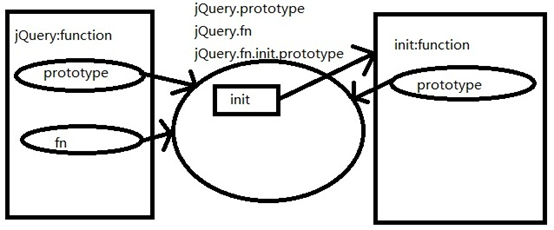http://www.imooc.com/code/3401
通过new操作符构建一个对象,一般经过四步:
A.创建一个新对象
B.将构造函数的作用域赋给新对象(所以this就指向了这个新对象)
C.执行构造函数中的代码
D.返回这个新对象
最后一点就说明了,我们只要返回一个新对象即可。其实new操作符主要是把原型链跟实例的this关联起来,这才是最关键的一点,所以我们如果需要原型链就必须要new操作符来进行处理。否则this则变成window对象了。
下面这个例子,console结果一样。因为都用了new 。如果不用new就不一样了。
var $$ = ajQuery = function(selector) { this.selector = selector;//this是aJquery {}name: "sss"__proto__: Object return this } var ins = new $$("111"); console.log(ins);// var $$2 = ajQuery2 = function(selector) { this.selector = selector; } var ins2 = new $$2("2222"); console.log(ins2);//
去掉new 后。ajQuery里的return this就起了作用。
var $$ = ajQuery = function(selector) { this.selector = selector; return this } var ins = $$("111"); console.log(ins);//window var $$2 = ajQuery2 = function(selector) { this.selector = selector; } var ins2 = $$2("2222"); console.log(ins2);//undefined
我们常见的类式写法:
var $$ = ajQuery = function(selector) { console.log(this instanceof ajQuery);//true ajQuery被new形式调用时,this就是ajQuery的实例 this.selector = selector; return this } ajQuery.fn = ajQuery.prototype = { selectorName:function(){ return this.selector; }, constructor: ajQuery } var ins = new $$("111"); console.log(ins.selectorName());
首先改造jQuery无new的格式,我们可以通过instanceof判断this是否为当前实例
var $$ = ajQuery = function(selector) { console.log(this);//先是window,再是ajQuery的实例 if(!(this instanceof ajQuery)){ return new ajQuery(selector); } this.selector = selector; return this } ajQuery.fn = ajQuery.prototype = { selectorName:function(){ return this.selector; }, constructor: ajQuery } var ins = $$("111"); console.log(ins.selectorName());
注意千万不要像下面这样写:
var $$ = ajQuery = function(selector) {
this.selector = selector;
return new ajQuery(selector);
}
Uncaught RangeError: Maximum call stack size exceeded
这样会无限递归自己,从而造成死循环并且溢出。
jQuery为了避免出现这种死循环的问题,采取的手段是把原型上的一个init方法作为构造器。
function aJquery(selector){ return new aJquery.fn.init(selector); } aJquery.fn = aJquery.prototype = { showName:function(){ console.log(this.name) }, init: function(){ console.log(this); } } var a = aJquery("sss"); a.showName();//报错
这样确实解决了循环递归的问题,但是又问题来了,init是ajQuery原型上作为构造器的一个方法,那么其this就不是ajQuery了,所以this就完全引用不到ajQuery的原型了(showName报错),所以这里通过new把init方法与ajQuery给分离成2个独立的构造器。
静态与实例方法共享设计
jQuery遍历方法:
$(".aaron").each() //作为实例方法存在
$.each() //作为静态方法存在
这是最常见的遍历方法,第一条语句是给有指定的上下文调用的,就是(".aaron")获取的DOM合集,第二条语句$.each()函数可用于迭代任何集合,无论是“名/值”对象(JavaScript对象)或数组。在迭代数组的情况下,回调函数每次都会传递一个数组索引和相应的数组值作为参数。本质上来说2个都是遍历,那么我们是不是要写2个方法呢?
我们来看看jQuery的源码:
jQuery.prototype = {
each: function( callback, args ) {
return jQuery.each( this, callback, args );
}
}
var Newobj = function(name){ this.name = name; } Newobj.showName = function(args){//静态方法:不能被实例对象调用 console.log(args); } Newobj.prototype = { showName: function(args){//实例方法 return Newobj.showName(this.name + args ); } } var s = new Newobj("sss"); s.showName("bbb");//sssbbb
实例方法取于静态方法,换句话来说这是静态与实例方法共享设计,静态方法挂在jQuery构造器上,原型方法挂在哪里呢?
我们上节不是讲了内部会划分一个新的构造器init吗?jQuery通过new原型prototype上的init方法当作构造器,那么init的原型链方法就是实例的方法了,所以jQuery通过2个构造器划分2种不同的调用方式一种是静态,一种是原型。
方法是共享的,并且实例方法取于静态方法,2个构造器是完全隔离的 ,这个要如何处理?
看看jQuery给的方案:
画龙点睛的一处init.prototype = jQuery.fn,把jQuery.prototype原型的引用赋给jQuery.fn.init.prototype的原型,这样就把2个构造器的原型给关联起来了。
ajQuery.fn = ajQuery.prototype = {
name: 'aaron',
init: function(selector) {
this.selector = selector;
return this;
},
constructor: ajQuery
}
ajQuery.fn.init.prototype = ajQuery.fn
这段代码就是整个结构设计的最核心的东西了,有这样的一个处理,整个结构就活了!不得不佩服作者的设计思路,别具匠心。
看看init的的构造图:
(单击图片查看大图)
通过原型传递解决问题,把jQuery的原型传递给jQuery.prototype.init.prototype。换句话说jQuery的原型对象覆盖了init构造器的原型对象,因为是引用传递所以不需要担心这个循环引用的性能问题。
var $$ = ajQuery = function(selector) { //把原型上的init作为构造器 return new ajQuery.fn.init( selector ); } ajQuery.fn = ajQuery.prototype = { name: 'aaron', init: function(selector) { this.selector = selector; return this; }, constructor: ajQuery } ajQuery.fn.init.prototype = ajQuery.fn; ajQuery.fn.foo = function () { alert("foo!"); }; ajQuery(".some-selector").foo(); //挂在ajQuery.fn上的实例方法变成了ajQuery(ajQuery.fn.init)上的原型方法
现在的ajQuery(".some-selector")

原型中有foo有init。
http://stackoverflow.com/questions/1755080/why-jquery-do-this-jquery-fn-init-prototype-jquery-fn
